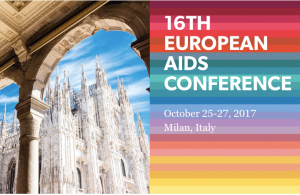Fostemsavir in highly treatment-experienced participants: 24-week phase 3 results
28 November 2017. Related: Conference reports, Antiretrovirals, EACS 16 Milan 2017.
 Simon Collins, HIV i-Base
Simon Collins, HIV i-Base
The most important results at EACS 2017 on new pipeline compounds were the first phase 3 results for the investigational entry inhibitor fostemsavir.
As with any first drug in a new class, this data will provide hope for people with multidrug HIV resistance and whose combination is failing. For people in this situation, fostemsavir could be a life-saving drug.
This was a randomised, blinded, placebo-controlled international study in 272 treatment experienced participants currently on virologically failing combination and with drug resistance to at least two classes.
The study design included randomisation (3:1) to either fostemsavir 600 mg twice-daily or matching placebo for eight days, while remaining on failing ART, and then optimising the background regimen (OBR), which included the option to add other investigational drugs. The study also enrolled an additional 99 participants to open-label fostemsavir who had no other fully active ARV options, who were allowed to optimise background therapy from day one.
Although the primary endpoint was viral suppression to <40 copies/mL at day 8 in the randomised group, all participants had 24-week results for secondary efficacy and safety endpoints. In addition to allowing other investigational drugs during the optimisation phase, follow-up is planned to weeks 48 and 96, and to then continue until the next pipeline drug becomes available.
This was an advanced patient group with CD4 count at screening less than 200 cells/mm3 in 72% and 50 cells/mm3 in 41% of the group. Previous use of integrase inhibitors and protease inhibitors were reported for 80% and 96% respectively.
Baseline characteristics for the randomised group included median age 44 years (range 18 to 73) and approximately 30% were women. Median (range) CD4 and viral load were approximately 100 cells/mm3 (0 to 1160) and 4.7 log copies/mL (1.6 to 6.9), respectively. Approximately 10% had no fully active drugs in the OBR, with 40-50% having either 1 or 2 fully active drugs.
Baseline characteristics were similar for the open-label group, with the important exception that 80% had no active drugs in the OBR and 20% had only one active drug. In this group, >95% had integrase experience and 70% had used T-20. Of the 19 people with sensitivity to one drug, 13/19 used the investigational mAb ibalizumab (See Table 1).
At day 8, mean viral reductions were was 0.79 vs 0.17 log copies/mL for fostemsavir vs placebo arms respectively, (difference: –0.625; 95%CI: –0.810 to –0.441, p< 0.0001). By intent-to-treat (ITT) analysis 65% had >0.5 log reductions and 46% had >1 log reductions. In sub-group analysis of participants with baseline viral load >1000 copies/mL, the median viral load decline was –1.0 log copies/mL.
By week 24, viral suppression was reported for 54% of participants, with 71% and 77% using <200 and <400 copies/mL cut-offs respectively.
In the open-label group, 36% reported viral load <40 copies/mL at week 24. These rates were 49% and 53% using <200 and <400 copies/mL thresholds. For 80% of this group fostemsavir was the only active drug. Median viral reduction were –0.63 log copies/mL (95%CI: –0.81 to –0.44).
Mean CD4 counts increased by 90 and 41 cells/mm3 in the randomised and open-label groups respectively.
Side effects were generally mild and manageable but serious complications reflected how advanced HIV was in this population. Although 91% of participants reported side effects (mostly grade 1-2), 30% experienced a serious event, including 13 people with pneumonia. Side effects leading to discontinuation were reported by 12 (4%) participants in the randomised group vs and 9 (9%) in the open-label group.
The urgency of treatment for this group with advanced HIV was shown by 17 participants who died, with 12/17 deaths due to AIDS/IRIS-related events and acute infections.
Fostemsavir is being developed by ViiV Healthcare from a compound that was acquired from BMS (BMS-663068).
| Randomised cohort | Open label cohort | |||
|---|---|---|---|---|
| Placebo BID (N=69) |
Fostemsavir 600 mg BID (N=203) |
Fostemsavir 600 mg BID (N=99) |
||
| Mean age, years, (range) | 43 (19 to 66) |
45 (18 to 73) |
48 (17 to 72) |
|
| Sex; Male [n (%)] | 57 (83) | 143 (70) | 89 (90) | |
| Median CD4 count (range) | 100 (0 to 915) |
99 (0 to 1160) |
41 (0 to 641) |
|
| Median viral load (range) | 4.5 (1.6 to 6.9) |
4.7 (1.6 to 6.4) |
4.3 (1.6 to 6.6) |
|
| No. fully active drugs in OBT | 0 | 5 (7%) | 21 (10%) | 80 (81%) |
| 1 | 28 (41%) | 103 (51%) | 19 (19%) * | |
| 2 | 36 (52%) | 79 (39%) | 0 | |
* 13/19 participants used ibalizumab
Comment
Although the current number of people with multidrug resistance is relatively low, this is a group in the highest need.
It is therefore essential that research companies invested in compounds in new drug classes.
As integrase inhibitors become more widely used, multidrug resistance likely to increase, further emphasising the need for future options.
Reference:
Lataillade M et al. Phase 3 study of fostemsavir in heavily treatment experienced HIV-1 infected subjects: day 8 and week 24 primary efficacy and safety results (BRIGHTE Study, Formerly AI438-047). 16th EACS, 25-27 October 2017. Oral abstract PS8/5.

